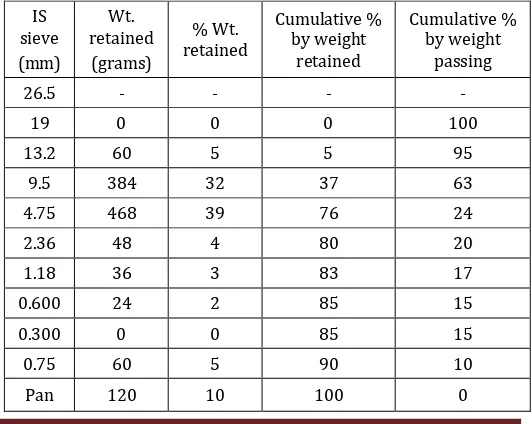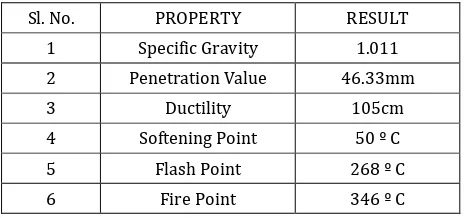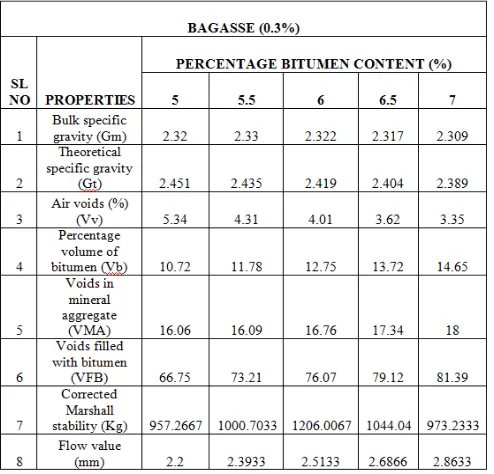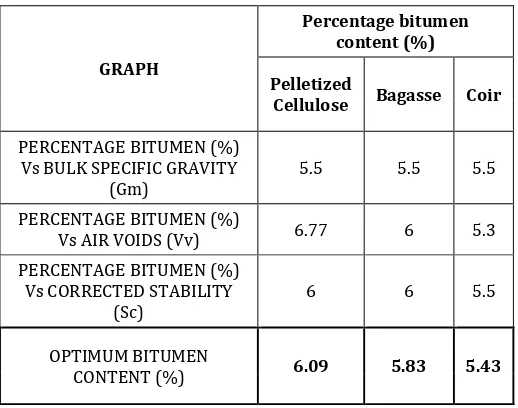© 2018, IRJET | Impact Factor value: 6.171 | ISO 9001:2008 Certified Journal | Page 300
EXPERIMENTAL INVESTIGATION OF STONE MASTIC ASPHALT BY
VARYING MIX DESIGN
Prerana C Shekar
1, Rajath B H
2, J S Vishwas
31,2
Under Graduate Student, Department of Civil Engineering, PES University, Bengaluru, Karnataka, India
3Assistant Professor, Department of Civil Engineering, PES University, Bengaluru, Karnataka, India
---***---Abstract
- Stone Matrix Asphalt (SMA) is a gap-graded mix which consists of a high concentration of coarse aggregate which is held together by a matrix of mineral filler and stabilizers in a thick asphalt film. In this study comparison of strength of pavement wearing coat with SMA mix with conventional fibre i.e., cellulose fibre and non-conventional natural waste fibre such as bagasse and coconut fibre was done. This research was to evaluate the viability of natural fibres as a stabilizing agent in the mixture and thereby obtain the optimum bitumen content for the fibres by laboratory tests in which the flow parameter and the mechanical properties of the mixture was analyzed. The aggregate gradation of the SMA mix was adopted as per the IRC:SP:79 - 2008 specification and the binder content was 5%, 5.5%, 6%, 6.5%, 7% by weight of aggregate and fibre used was 0.3% by weight of aggregate. For this we used finely divided hydrated lime as filler and VG-30 (Viscosity Grade) bitumen as binder.Key Words: Stone Mastic Asphalt (SMA), Pelletized
Cellulose Fibers, Bagasse, Coir, Marshall Stability Test1. INTRODUCTION
Studded tires were a trend in Germany during the early 60s. This caused a lot of effects on the pavement wearing course and thereby decreased the life of the courses. To overcome this drawback Stone Mastic Asphalt was founded. [3] It is a mastic containing a coarse aggregate skeleton which helps in even distribution of the on-coming loads. SMA increases the life of the wearing course and has many benefits. It has drawbacks like fat spots and bleeding, to overcome this stabilizers like Pelletized Cellulose fibre are used to curb the drain down effect of the mix. All the materials used in a SMA mix makes it expensive. Therefore this study is done to substitute the expensive stabilizer with a non-conventional fibre such as waste products to decrease the cost. Then the Optimum Binder Content (OBC) is found out to make the SMA mix completely cost effective and also decrease the amount of waste fibres generated Southern India is known for the sugar industries and huge amounts of bagasse are produced every year. Usage of such waste products will also lessen the burden on the environment.
The tests were conducted as per the Indian Standards and MORTH specifications. [2]
2. MATERIALS
The materials used in this research work was coarse aggregates, bitumen, filler and stabilizer. The coarse
aggregates of different gradation were obtained from a quarry in the outskirts of Bengaluru. Bitumen of Viscosity Grade (VG) 30 was obtained from an asphalt plant in Mangalore. Fillers can be rock dust, slag dust, hydrated lime, etc. In this work we used 20% of hydrated lime and 80% of fine aggregate passing through 75µ (micron) sieve was used. Pelletized Cellulose fibres are used as stabilizers or drainage inhibitors in the SMA mix, but here we have replaced the conventional fibre with non-conventional fibre such as bagasse and coir to check for their effects imparted on the mechanical properties of the SMA mix.
2.1 Aggregates [5]
[image:1.595.300.566.574.786.2]The test procedure for aggregates were followed as per IS 2386 - Part I. The aggregates of different sizes varying from 19 mm to 75µ (micron) was obtained. Quality of the aggregates were checked by performing varying tests as per IRC: SP: 79 - 2008 specifications in Table 1. [1]
Table-1: Tabulation for coarse aggregate properties
Sl. No. PROPERTY RESULT 1 Flakiness Index 18.822% 2 Elongation Index 17.612% 3 Los Angeles Abrasion Value 16.52%
4 Impact Value 15.42%
5 Specific Gravity 2.652
Table-2: Gradation of Aggregates
IS sieve (mm) Wt. retained (grams) % Wt. retained Cumulative % by weight retained Cumulative % by weight passing
26.5 - - - -
19 0 0 0 100
13.2 60 5 5 95
9.5 384 32 37 63
4.75 468 39 76 24
2.36 48 4 80 20
1.18 36 3 83 17
0.600 24 2 85 15
0.300 0 0 85 15
0.75 60 5 90 10
© 2018, IRJET | Impact Factor value: 6.171 | ISO 9001:2008 Certified Journal | Page 301 Gradation of the aggregates required for the mix is done
according to IRC: SP: 79 - 2008, Table 3. We have adopted 19mm SMA which is used as Binder Course. The total weight of sample taken was 1200grams.
2.2 Bitumen
[image:2.595.46.278.249.358.2]Bitumen is the binder which holds the mastic together. We have used 5%, 5.5%, 6%, 6.5%, 7% of Viscosity Grade 30 (VG 30) bitumen by weight of aggregate for this research work as per IRC:SP:79 - 2008 specification. The tests for bitumen was conducted as per IS 1202 and IS 1203 - 1978 specifications.
Table-3: Tabulation for bitumen properties
Sl. No. PROPERTY RESULT 1 Specific Gravity 1.011 2 Penetration Value 46.33mm 3 Ductility 105cm 4 Softening Point 50 º C 5 Flash Point 268 º C 6 Fire Point 346 º C
2.3 Fibres
The drain down effects are minimized using the stabilizers or the fibres. In this work we have compared conventional fibre, Pelletized Cellulose [8] with non-conventional fibres such as Bagasse and Coir [9]. According to IRC: SP: 79 - 2008 Clause 3.5, 0.3% of fibre by weight of aggregate was used in the SMA Mix.
Table-4: Tabulation for specific gravity of fibre
Sl. No. FIBRE SPECIFIC GRAVITY 1 Pelletized Cellulose 1.208
2 Bagasse 0.694
3 Coir 0.694
2.4 Fillers
Fillers are used in the mix for good binding properties. It constitutes from 8% to 12% of a mixture. We have used 20% hydrated lime and 80% fine aggregates passing through 75µ (micron) sieve.
Table-5: Tabulation for specific gravity of fillers
Sl. No. FILLER SPECIFIC GRAVITY 1 Hydrated Lime 2.24 2 Fine Aggregate 2.71
3. EXPERIMENTAL PROCEDURE
Sieve analysis was performed using IS sieves (Fig 3.11) of 19mm, 13.2mm, 9.5mm, 4.75mm, 2.36mm, 1.18mm, 600µ
(micron), 300µ (micron) and 75µ (micron). Amount of aggregates required for one SMA sample was 1200grams.
Weigh batching was performed according to Table 2 for preparing a SMA mould One mould consists of 1200grams of aggregate. The filler used is also weighed, we use 24grams of filler, 96grams of fine aggregate included in the aggregate gradation and 0.3% of fibre by weight of aggregate i.e., 3.6grams of stabilizers.
Heating aggregates and mould: The batched aggregates of one mould (1200grams) was heated in the hot air oven until it reached 180º C, along with this Marshall Stability moulds including the base plate were heated.
Heating bitumen: VG 30 bitumen was heated to a temperature of 150º C so that it is easy to be mixed well with the aggregates, filler and the stabilizers.
Mixing the components: After the aggregates are heated to a temperature of 180 º C, it was mixed with the weighed amount of stabilizer and hydrated lime. Later bitumen in amounts of 5, 5.5, 6, 6.5 and 7% was added to prepare the specimen.
Compaction: The homogenous SMA mix was placed in the cylinder mould and subjected to compaction from the standard rammer. The specimen was compacted by 50 blows on each face. [6]
Extraction of the specimen: After the compacted specimen cools down, the specimen is extracted from the mould and then tagged respectively.
A total of 45 specimens were prepared, 15 specimens for each fibre i.e., Pelletized Cellulose, Bagasse and Coir.
3.1 Marshall Stability Test [7]
Marshall Stability Test was conducted as per ASTM D 6927 - 06 specifications and procedure.
Air weight and submerged weight of the extracted specimen was obtained and then the specimen was placed in the hot-water bath at 60 º C for a duration of 30 minutes. Later, it was subjected to Marshall Stability test. The specimen was placed in the breaking head and the load was applied gradually. The stability and flow value were obtained from their respective dial gauges.
4. Parameters Calculated
1. Specific Gravity of the mix (Gt)
2. Bulk specific gravity (Gm) of the mix
3. Percentage Air voids (Vv) in the mix
4. Percentage volume of bitumen (Vb) in the mix
© 2018, IRJET | Impact Factor value: 6.171 | ISO 9001:2008 Certified Journal | Page 302
5. RESULTS
[image:3.595.42.295.138.396.2]TABLE-6: Properties of Stone Mastic Asphalt (Pelletized Cellulose)
TABLE-7: Properties of Stone Mastic Asphalt (Bagasse)
TABLE-8: Properties of Stone Mastic Asphalt (COIR)
5.1 Graphs
Fig-1: Percentage bitumen Vs Bulk specific gravity
Fig 1, shows that the graph of Bulk Specific Gravity Vs Bitumen Content is a smooth curve with maximum,
Bulk Specific Gravity of 2.326 obtained at 5.5% Bitumen Content for Pelletized Cellulose.
Bulk Specific Gravity of 2.330 obtained at 5.5% Bitumen Content for Bagasse.
[image:3.595.43.290.433.670.2]© 2018, IRJET | Impact Factor value: 6.171 | ISO 9001:2008 Certified Journal | Page 303 Fig-2: Percentage bitumen Vs Air voids
Fig 2, shows that, as Percentage Bitumen Content increases the Percentage Air Voids (Vv) in the mix decreases. For determination of Optimum Bitumen Content, Bitumen Content (%) corresponding 4% Air Voids, is considered.
Which is,
[image:4.595.42.560.37.261.2]6.77% for Pelletized Cellulose, 6% for Bagasse, 5.3% for Coir.
Fig-3: Percentage bitumen Vs VFB
Fig 3 shows that, as Bitumen Content (%) increases, Percentage Voids Filled with Bitumen (VFB) also increases.
Maximum value of,
VFB obtained was 79.26% for 7% Bitumen Content for Pelletized Cellulose.
VFB obtained was 81.39% for 7% Bitumen Content for Bagasse.
VFB obtained was 85.33% for 7% Bitumen Content (Coir).
Fig-4: Percentage bitumen Vs Corrected stability [4]
From Fig 4, it can noted that with an increase in the Bitumen Content (%) (Bagasse) the Corrected Stability increases gradually to the maximum Stability and decreases. It is a smooth curve with maximum,
Corrected Stability of 1242.1433Kg obtained at 6% Bitumen Content for Pelletized Cellulose Fibre.
Corrected Stability of 1206.0067Kg obtained at 6% Bitumen Content for Bagasse.
Corrected Stability of 1212.8867Kg obtained at 5.5% Bitumen Content for Coir.
Fig-5: Percentage bitumen Vs Flow value
Fig-5: shows that with an increase in the Bitumen Content (%) (Pelletized Cellulose Fibre) the Flow Value increases linearly
5.2 Optimum Bitumen Content (OBC)
The optimum bitumen content for SMA mix is derived by taking the average bitumen content of the following:
[image:4.595.36.289.400.564.2] [image:4.595.308.559.444.613.2]© 2018, IRJET | Impact Factor value: 6.171 | ISO 9001:2008 Certified Journal | Page 304
Binder content corresponding to the median of designed limits of percent air voids (Vv) in the total mix (i.e. 4%)
[image:5.595.36.295.180.384.2] Binder content corresponding to maximum stability (Corrected Stability)
TABLE-9: Tabulation for Optimum Bitumen Content
GRAPH
Percentage bitumen content (%)
Pelletized
Cellulose Bagasse Coir
PERCENTAGE BITUMEN (%) Vs BULK SPECIFIC GRAVITY
(Gm) 5.5 5.5 5.5
PERCENTAGE BITUMEN (%)
Vs AIR VOIDS (Vv) 6.77 6 5.3 PERCENTAGE BITUMEN (%)
Vs CORRECTED STABILITY
(Sc) 6 6 5.5
OPTIMUM BITUMEN
CONTENT (%) 6.09 5.83 5.43
Therefore, the Optimum Bitumen Content (OBC), obtained from graphs of Bulk Specific Gravity, Air Voids and Corrected Stability,
For SMA Mix containing Pelletized Cellulose Fibre is found to be 6.09%.
For SMA Mix containing Bagasse is found to be 5.83%.
For SMA Mix containing Coir is found to be 5.43%.
6. SUMMARY
The objective of this work was to obtain the Optimum Bitumen Content (OBC) for SMA mix and also monitor the expenses, since SMA is usually not preferred due to its cost. To make it cost effective we replaced the conventional fibre with non-conventional fibre i.e., Bagasse and Coir. Another drawback of SMA is the drain down and fat spots due to the bitumen content.
The following were interpreted from the results obtained:
1. As obtained from the Stability Vs Bitumen Content graphs, specimen using coir as fibre has the least OBC 5.5% with a maximum stability of 1213 kg and pelletized cellulose fibre has a higher OBC 6% with the highest stability of 1242 kg.
2. Flow value of a specimen should increase with the increase in binder content and all the three types of
fibres showed the same behavior. Considering the amount of flow, bagasse tends to hold the flow of the specimen despite an increase in the bitumen content. It records a flow of 2.9mm for 7% bitumen while others pose a comparatively higher flow. Therefore, for higher percentages of bitumen bagasse can be used as a stabilizer.
3. Theoretically Voids Filled with Bitumen (VFB) should remain constant for a particular aggregate gradation with respect to binder content, but by practicals it is observed that at low bitumen content, VFB slowly decreases then increases after a pause. The initial drop in VFB is due to re-orientation of aggregates in presence of bitumen, but in our work it is seen that VFB increases as binder increases. This may be assumed to be due to the thicker bitumen film which moves the aggregates slightly apart thereby resulting an increase of VFB.
4. Air voids (Vv) are supposed to decrease with an increase in the bitumen content. The results obtained are in accordance with the argument. Considering that OBC is obtained by determining the bitumen content corresponding to 4% of Vv, coir has a bitumen content of 5.3% when compared to 6.77% of pelletized cellulose fibre and 6% of bagasse.
7. CONCLUSION
Considering all the properties and parameters of the mix we can consider using coir as fibre as it provides a considerable amount of stability for a non-conventional fibre. Examining the flow value the least being 2.9mm of bagasse, coir gives a flow of 3.05mm for 7% bitumen content. Considering the stability, coir can be opted over bagasse. For 4% Air voids, Coir has a lesser bitumen content and can be considered as the OBC. Therefore to conclude, coir renders a cost effective procedure and therefore can be used in general heavy traffic and severe traffic requirements.
8. FUTURE SCOPE
In future performance of coir with other grades and content of bitumen can be tested and comprehend whether it can be used successfully or not.
Use of coir may also be tested not only for SMAs but also for different other HMAs and Super paves.
Repeated load testing can give an outlook about the fatigue failure resistance of the specimen.
Wheel tracking test can give a view about the rut resistance of the specimen.
© 2018, IRJET | Impact Factor value: 6.171 | ISO 9001:2008 Certified Journal | Page 305
9. REFERENCES
[1] Manual for Tentative Specifications for Stone Mastic Asphalt, IRC:SP:79 - 2008
[2] Manual for construction and supervision of bituminous works, MoRTH, IRC, New Delhi, 2001
[3] Krzysztof Blazejowski, “Stone Matrix Asphalt-Theory and Practice”, 2011
[4] “Resistance to Plastic Flow of Bituminous Mixtures Using Marshall Apparatus", ND T 245, AASHTO T 245
(http://www.dot.nd.gov/manuals/materials/testi ngmanual/t245.pdf)
[5] IS 2386 : Part I : 1963 (Reaffirmed 2002) , Methods of Test for Aggregates for Concrete : Particle Size and Shape
[6] D-6926-04 ,Standard practice for preparation of Bituminous Specimens using Marshall Apparatus
[7] D-6927-06, Standard Test Method for Marshall Stability and Flow of Bituminous Mixtures
[8] A. R. Woodside, W. D. H. Woodward, H. Akbulut, “Stone Mastis Asphalt: assessing the effect of cellulose fibre additives”, Proc. Instn Civ. Engrs Mun. Engr, 1998, 127, Sept., 103-108
[9] Majid Ali, “Coconut Fibre – A Versatile Material and its Applications in Engineering”, Coventry University and The University of Wisconsin Milwaukee Centre for By-products Utilization, Second International Conference on Sustainable Construction Materials and Technologies, June 28 -
June 30, 2010
(http://citeseerx.ist.psu.edu/viewdoc/download?d oi=10.1.1.823.5053&rep=rep1&type=pdf)
AUTHOR BIOGRAPHIES
Prerana C Shekar
Senior under-graduate student, Department of Civil Engineering, PES University, Bengaluru, India
Rajath B H
Senior under-graduate student, Department of Civil Engineering, PES University, Bengaluru, India
J S Vishwas



![Fig-4: Percentage bitumen Vs Corrected stability [4]](https://thumb-us.123doks.com/thumbv2/123dok_us/8129460.796503/4.595.42.560.37.261/fig-percentage-bitumen-vs-corrected-stability.webp)
